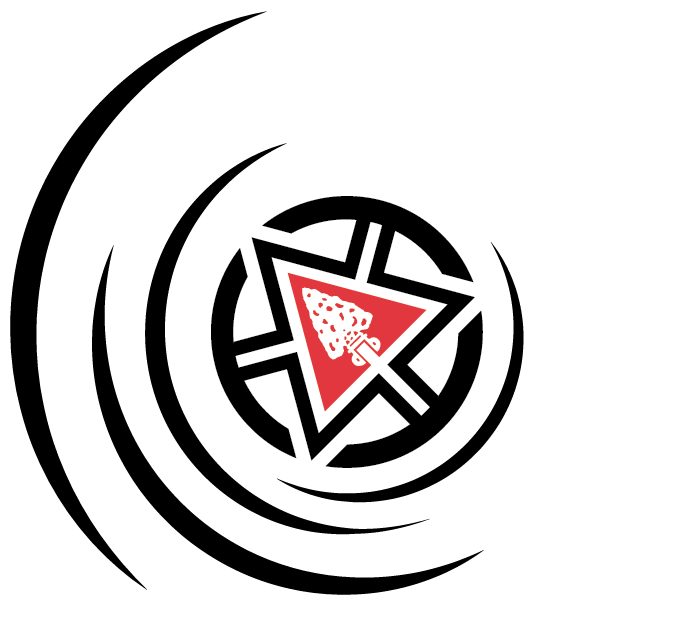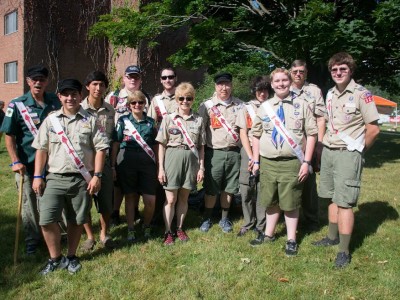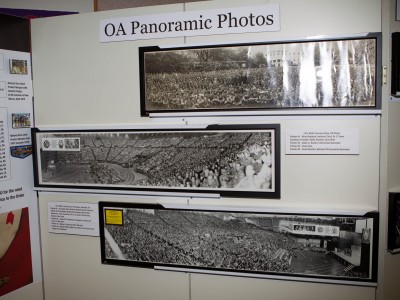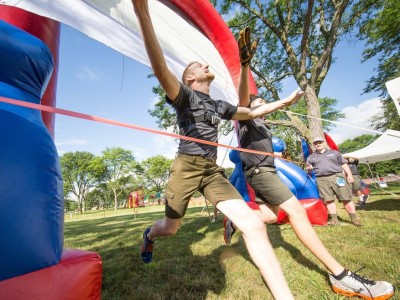The Goodman Edson Observatory—a walk through service, history and people

By Justin Schimmel
For Arrowmen interested in the history of the Brotherhood of Cheerful Service, the Goodman Edson Observatory (GEO) in the Kellogg Center will provide a fascinating array of exhibits and artifacts.
Paintings, Treasure Island soil, 90 year old sashes and other features document the exciting history of our brotherhood. Generally, exhibits are ordered sequentially from 1915 to 2015 and together the exhibits are the largest collection of OA memorabilia in history.
On arriving at GEO, a visitor can sign the Induction Board, providing his or her name, year and location of induction into the Order. The board, along with boards from NOAC 2012, may be archived at the National Scouting Museum after NOAC 2015 ends.
Visitors will watch a short film about E. Urner Goodman’s selection as the first Vigil Honor member. The film, relying on audio recordings of Goodman, is the sequel to NOAC 2012’s The First Induction. The cinematic presentation can be seen by members of all honor levels and will be an enhancing preface to the museum. “It is unique to actually see the history of the Order,” said Josh Shelhamer, the communications director of the GEO.
The second experience in the museum starts with the Treasure Island Camp and the first induction experience. A large display screen will livestream participants’ postings on Instagram and Twitter using the hashtag #NOACGEO. Visitors are encouraged to bring a phone or tablet device, and they will also be able to use their Spark devices.
Arrowmen will also want to see the artwork scattered throughout the observatory. The artwork includes paintings from the National Scouting Museum as well as a painting from the dining hall at Treasure Island. It is the largest painting on display, weighing over 300 pounds.
After NOAC 2015, the Treasure Island painting will be permanently archived at the National Scouting Museum. Another important piece of artwork is the OA’s centennial logo, which was developed by Nathaniel Kelton. His original drafts, the paper he drew it on and the final product are all on display.
Other fascinating items from OA history are on exhibit, such as ice cream aprons from decades’ worth of NOACs. The museum houses a time capsule that will be opened later this week. A folio wall of patches from every lodge is in the middle of the museum, which also features a hall of sashes. Graciously assembled by donors, this hall contains every representation of the OA sash from 1915 to today.
The Order’s historical leadership also is documented in the observatory. Bonnets for the national chief and national vice chief are on display. Worn exclusively by the national chief and national vice chief, the bonnets feature specially approved golden eagle feathers and are important symbols of leadership. The museum’s Wall of National Chiefs starts with Goodman and ends with Alex Call. Finally, at an exhibit called the Summit Circle, Arrowmen will have the opportunity to take some Treasure Island soil to keep as a collector’s item.
The GEO is more than exhibits: The observatory’s Legacy Speaker Series features a series of talks and reminiscences covering the Order’s historical development. For example, participants from a NOAC that was over sixty years ago in 1948 will be hosting part of the series. The incorporation of Brotherhood, Cheerfulness and Service can truly be felt in the living and nonliving aspects of the Goodman Edson Observatory. It will be open all week, so be sure to come out and be a part of history by experiencing the past 100 years of it!



